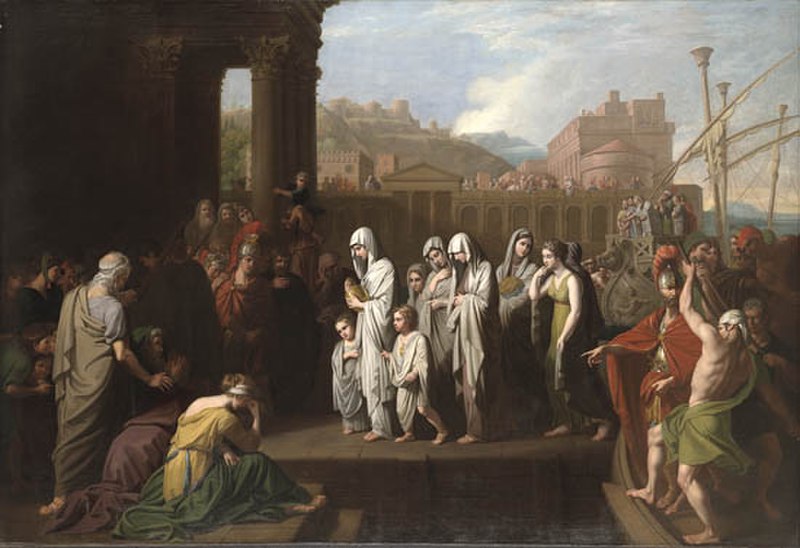
I was most distressed to read about the escalating destruction of the beautiful Roman ruins in Libya by looters interested in just making a quick dinar. What is even more distressing is that there are still so many highly educated people with so little morality that they are willing to buy fragments of such desecrated artwork.
[Image - plundered statues in the ruins of Cyrene, Libya. Photo courtesy of Iason Athanasiadis]I'm sure they rationalize it to themselves and their "friends" - if you can call the hoard of sycophants or thinly disguised business associates masquerading as friends by that appellation - by claiming they are saving the artifacts from the common rabble and taking better care of the art than a mere institution could. But the bottom line is they are merely satiating their own lust to own something their associates can't and in the meantime they are denying the rest of society access to our own collective heritage.
When Libya opened to the West in 2003, it was widely hailed as a crucial first step by a “terrorist” regime coming in from the cold. But along with the legitimate companies vying to capture Libya’s lucrative markets, international antiquities-smuggling gangs were waiting for their chance to pilfer the country’s Roman ruins, which are some of the most pristine in the world.
This trade, which first began in 1987 with the opening of the Egyptian border, has accelerated since 2003 with an unprecedented gutting of Libya’s ancient heritage sites underway since.
“There’s been an explosion in looting all over the Mediterranean, but in North Africa it’s really becoming quite a problem,” said Gaetano Palumbo, the North Africa programme director for the World Monuments Fund, a New York-based organisation.
Ancient ports, villas and entire Roman cities have been uncovered by western archaeologists after being buried under the Saharan sand for centuries.
Farther inland, preserved Roman farming communities or semi-fortified towers wait to be discovered. The structures are inlaid with elaborate mosaics and covered with inscriptions, providing valuable insights into the everyday life of what was one of the Roman Empire’s wealthiest provinces...
...most antiquities are smuggled out of Libya across the porous land border with Egypt. Once in Cairo, much of the time they are spirited out by foreign diplomats who have access to their embassy’s diplomatic pouch. Alternatively, boats smuggle them across the Mediterranean to Europe.
“Antiquities usually leave the Middle East by ships from Haifa headed to New York,” said Eleni Papaefthymiou, an Athens-based art historian and expert in ancient coins. “From Greece, coins, busts or entire statues are stored in agricultural produce lorries, disguised among sacks of potatoes and peaches.“From Libya they leave by boat to Italy and Marseille,” Ms Papaefthymiou said. “Large statues that weigh up to five tonnes are removed in cargo ships leaving from ports run by co-opted customs officers.”
Libyan officials will admit off the record that looting has severely damaged the spectacular and extensive Roman ruins spread across their country’s 2,000km-long Mediterranean coastline. But they shy away from direct criticism for fear of incurring their government’s wrath or of offending Egypt, Libya’s neighbour and ally. - More: The National

However, the Green Mountain Development Plan, unveiled two years ago, may be a way to thwart the plunder by enlisting the assistance of a powerful coalition of the Libyan government, UNESCO and commercial investors to preserve the archaeological sites and incorporate them into an ecologically designed cultural center that will fuel a lucrative tourism-based economy.
Envisioned by Saif Qaddafi, the son of Libya's president, "...the Green Mountain project is ambitious.
Its energy is to come from the wind and solar power. Its waste is to be recycled, its trash converted to biofuel. Its buildings - resorts, hotels, villas and villages for locals - are to blend seamlessly into the rugged landscape.
The plan will protect Libya's fantastic Greek and Roman ruins, as well its fragile coastal ecosystem - one of the last remaining natural areas of the Mediterranean - from the perils of haphazard development. The idea is that as Libya opens to the outside world, it will not become "like the Spanish coast," said the project's financial adviser, Mahmoud Khosan. It will also be a good investment.
With a brand name British architectural firm, Foster and Associates, designing the "Green Mountain Conservation and Development" zone, and Unesco helping with restorations, there is no shortage of star power..."
The Libyan coast is "a unique and important and untouched ecosystem, almost the only one left in the Mediterranean," said Alessandra Pome of the World Wildlife Foundation in Tripoli, noting that it is the last breeding ground for turtles and tuna in the Mediterranean Sea." - More: New York Times
Apparently, the coastline identified as the target of the Green Mountain project is also home to an endangered species of seal as well.
I know some purists may shudder at the thought of resort hotels in this cultural treasure trove but realists must surely recognize that as long as local inhabitants have few alternatives to support themselves and their families, the lure of looting will continue to be irresistible. As an ecologically planned travel destination, it will certainly have more aesthetic appeal than sites bordered by the crush of high density population centers like Herculaneum.
At the time the NY Times article was written in September 2007, the Green Mountain Project was mostly vision. But since then, the Libyan government apparently has made some progress as local looters are starting to complain about government crack downs on attempts to exploit sites within the Green Mountain perimeter.
To see a beautiful slideshow of the region visit the
Foster and Associates Project Site.



